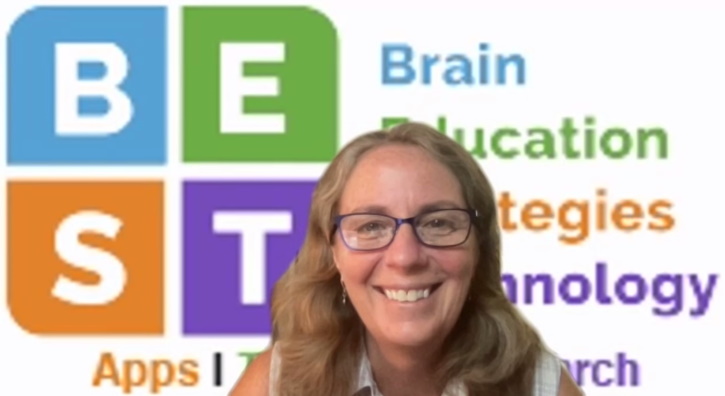Co-founder of BEST Michelle Ranae Wild and her team developed a suite of five applications for the brain injury community.
Technology Tools for Cognitive Performance
By Eliza Marie Somers
Technology can be daunting for many brain injury survivors, but it also can be a supportive tool that can help many survivors and their caregivers with everyday tasks that once were easy and now take more time and energy to perform.
“Technology is like a cognitive rehabilitation tool in your hand,” said Michelle Ranae Wild at the August 13, 2021, Brain Injury Hope Foundation Survivor Series: Technology Tools for Cognitive Performance. Wild is a co-founder of the nonprofit Brain Education Strategies and Technology (BEST), which developed a suite of five applications for the brain injury community.
“Apps are prosthetics for the brain,” added Kristi Kragthorpe, who is a brain injury survivor and co-founder of BEST.
- Michelle Ranae Wild [email protected]
- Kristi Kragthorpe [email protected]
- Lisa Hirsch [email protected]
The impetus for the applications goes back to the lack of cognitive rehabilitation therapy after a brain injury.
“In general, most people after a TBI don’t get exposure to cognitive rehab,” explained Wild, who also teaches at Coastline College’s Acquired Brain Injury Program, which will be offering a free webinar series on goal setting in September. “What our hope is that by using these apps and technology they will help survivors manage and navigate common day-to-day hurdles after a brain injury.”
One reason insurance companies pay for only a few months, if any, of cognitive therapy is because the focus is on restorative rehab therapy, which is described by Wild as intense repetition and practice in specific cognitive domains: drill and practice, verbal mnemonic strategies, visual imagery method and specialized brain training programs.
“Most people think more about restorative rehab than compensatory rehab after a brain injury,” said Wild, who noted Lumosity and other brain games are examples of repetitive restorative rehabilitation. “One thing that is very different about restorative rehab is people often get better at a single task, but it does not generalize into everyday life.
“Most brain games improve certain things, such as attention span, and you get better scores on the games,” she added. “But if you don’t learn how to take those strategies and use them outside the games, you don’t improve your everyday life. … It’s not one or the other. It’s a combination of two different strategies that have to be addressed.”
Incorporating cognitive rehab can help a survivor learn new skills and strategies, as well as relearning what had been lost due to injury or illness. It also helps develop self-awareness, identify strengths and challenges, and allows for effective approaches to everyday challenges.
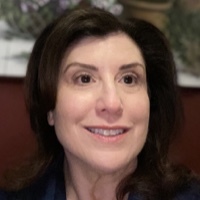
TBI survivor Dr. Lisa Hirsch, medical liaison with BEST, said she didn’t have to tools to help her recovery after years of therapy.
“Apps are workarounds for deficiencies,” said Dr. Lisa Hirsch, who is a brain injury survivor and a medical liaison with BEST. “Cognitive rehab focuses on neuroplasticity and repetition. It helps you process information differently. After two years of therapy, I was told this is where you are, and I didn’t have any tools to compensate for my deficiencies.”
She added that with the BEST Suite apps she now has the “tools to gain insights and awareness” of her deficiencies.
“Everything takes conscious effort,” Wild explained. “You have to decide where you want to put your energy, and it’s important to know where your energy goes.”
This is where the BEST Suite apps come in to play. A TBI survivor could memorize a shopping list, or use technology to create a list.
BEST Connections is offering a special discount for the BIHF community with a one-time cost of $9.99 for the BEST Suite, which normally costs $14.99, until Sept. 30. It is available for Apple devices, and will soon be available for Androids at the discounted price.
“We have a core group of apps you can use that will make it handy to use every day,” Wild explained. “Just like a toolbox, you don’t want it too heavy to handle, so we limited the number of apps.”
The five applications are written with the same interface, so once someone learns one application they can move on to the next app or onto an update with little heavy lifting. And with a limited number of apps, the suite won’t overwhelm users, making it easier to find information in the apps that can be used for multiple tasks.
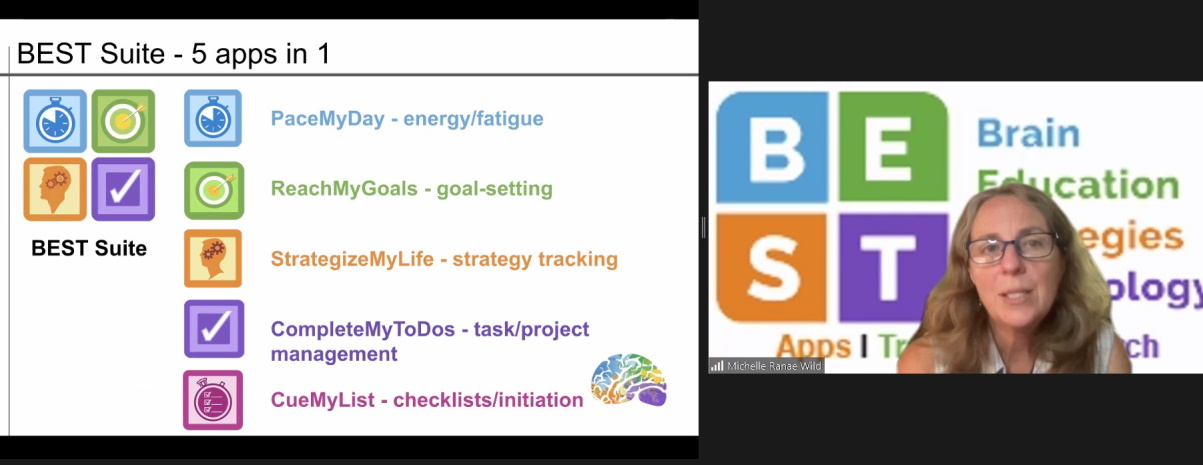
Michelle Wild explains the five apps in the BEST Suite.
What is in the BEST Suite?
The five applications in the suite are:
- PaceMyDay helps plan your day and learn to manage energy and fatigue.
- ReachMyGoals allows a user to set, monitor and accomplish goals.
- StrategizeMyLife helps document and track strategies that work for the user.
- CompleteMyToDos assists a user to accomplish more with specialized to-dos.
- CueMyList creates checklist and cues to move from one task to another.
Wild gave a brief explanation and examples of each application, which often overlap with each other, during the Survivor Series as Kragthorpe and Hirsch described how they use the BEST Suite apps.
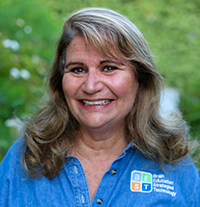
BEST co-founder Kristi Kragthorpe uses the CueMyList app to help with her grocery shopping and morning routine.
Kragthorpe said she uses the CueMyList app to help her with her morning routine.
“Before using the app I didn’t realize how long it took me to pick outfit,” she said. “When I used the app it helped me know if I was taking too long to pick an outfit. So now I limit it to two or three.”
She also likes the grocery store list as it is color coded to the different areas of the store, such as frozen foods, fruits and vegetables, etc.
Hirsch uses CueMyList for recipes as she was having a hard time remembering steps and ingredients when cooking or baking.
“I bake bread, and I was wondering why my bread was not rising. I was having these little bricks because I wasn’t following all the steps,” she explained. “It’s a coping mechanism for me.”
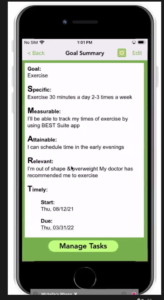
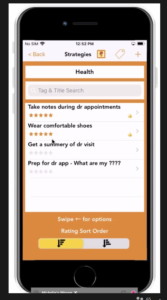
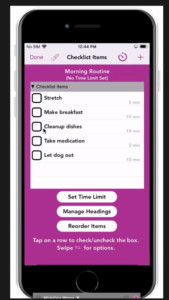
Examples of some of the apps in the BEST Suite.
StrategizeMyLife and PaceMyDay help users with task management and knowing what tasks are high energy vs. low energy tasks.
“PaceMyDay helps you assess how you feel before and how feel after a task,” Wild said. “Users learn what certain tasks trigger a headache or mood changes.”
ReachMyGoals and CompleteMyToDos allow users to celebrate successes, which Wild said is crucial during recovery.
“One thing that is difficult after a TBI is self-esteem and self-awareness. It’s really important to recognize and celebrate your successes because you don’t recognize that you are improving,” she said.
“I learned how to take breaks and pace my days after the TBI,” Kragthorpe said. “Sometimes it’s seen as being lazy, but if I kept trying to do a task and kept on going I would hit the wall and be done for the day or even the next day. I learned to break down tasks into manageable chunks.”
She also discovered that she was trying to “be the person she used to be.” Now she never puts too many high-energy tasks into one day.
Kragthorpe also noted she uses different apps at different times, because some days she’s on auto pilot and doesn’t need to use an app, and other days she needs them to “manage” her life.
Hirsch said, “I use the compensatory tools to help gain self-awareness after the TBI. I’m conscious about everything I do. I have learned to stop and not be spur of the moment and start being intentional.”
Learning the Apps
Once a user purchases the BEST Suite, Wild and her team offer online course and webinars on how to best use the technology to help people manage their days.
All three suggested taking one app at a time, and there is a questionnaire on the Best Connections website to help users determine what app to start using first.
“Learn one app at a time so you don’t get overwhelmed,” Kragthorpe said. “I used to keep huge checklists, but after the TBI it was cognitive overload. Each app brings different awareness and insights. These apps helped show me what my deficiencies were.”
BEST Connections offers classes and webinars to users to help them master the suite, using short training videos, screenshots with step-by-step instructions, exercises and quizzes. It also offers free cognitive skills and technology webinars two Saturdays a month, and if you are unable to attend the webinars will be available for two weeks.
“We are not here to push you,” Wild said. “We are her to help you figure out what best works for you.”
Other Apps, Tools For TBI Survivors
Notability: Allows user to take notes, link audio and pictures for organization. Users can store documents, handwrite notes or signatures, etc.
Inspiration Maps: Users can create graphic organized content and mind maps for ideas, projects and papers. It can be a great help for speech exercises.
Smart Pens: Converts notes to text that are searchable.

